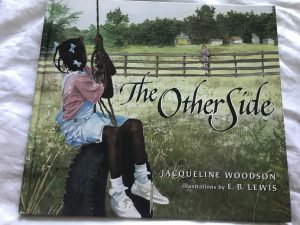 One of my favorite books to encourage children to discuss discrimination and racism is The Other Side by Jacqueline Woodson. Although I cannot meet with Joey in person yet, I found myself re-reading it with a view from how I would integrate it into my AAC work with Joey. It’s important for us to remember to share the same books and messages that we are reading and discussing with our typically developing students. The inability to engage in an oral conversation around an important topic does not mean we should shy away from it. Instead, we need to look into other ways to engage with all students.
One of my favorite books to encourage children to discuss discrimination and racism is The Other Side by Jacqueline Woodson. Although I cannot meet with Joey in person yet, I found myself re-reading it with a view from how I would integrate it into my AAC work with Joey. It’s important for us to remember to share the same books and messages that we are reading and discussing with our typically developing students. The inability to engage in an oral conversation around an important topic does not mean we should shy away from it. Instead, we need to look into other ways to engage with all students.
What About Next School Year?
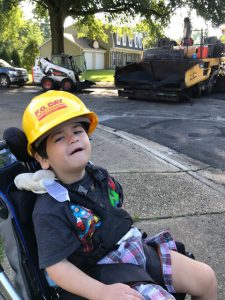 As our virtual learning school year has wrapped up in Northern Virginia, we are all left wondering what will be waiting for our students at the end of this summer “break”. The public schools are trying to figure out exactly how to walk the fine line between addressing a public health crisis while also maintaining high levels of instruction for children, and attempting to achieve programs that provide equity for all students. Truthfully, I am thankful I am not making the decisions. In the end, the decision made will inevitably leave many people frustrated. The truth is, there are no “right” decisions.
As our virtual learning school year has wrapped up in Northern Virginia, we are all left wondering what will be waiting for our students at the end of this summer “break”. The public schools are trying to figure out exactly how to walk the fine line between addressing a public health crisis while also maintaining high levels of instruction for children, and attempting to achieve programs that provide equity for all students. Truthfully, I am thankful I am not making the decisions. In the end, the decision made will inevitably leave many people frustrated. The truth is, there are no “right” decisions.
For my own typically developing children I have worries, but I also know we will be OK. They may not receive the great instruction they would in school, but being “behind” in first or third grade along with the rest of their peers is not going to topple them over in the long run. But for kids like Joey?
To succeed with AAC we need a strong foundation
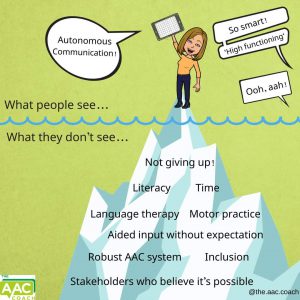 This picture from AAC Coach says so much about the nature of success with communication when using AAC. A few years ago I chatted with a college student who was able to fluidly answer my questions while typing on her iPad. It seemed impossible the story she was sharing was true – that until middle school she had been treated as though she had a significant intellectual disability, denied access to inclusive classrooms, and overheard teachers making comments that her parents “should just institutionalize her”. Yet here was this put together, bright college student who only stuck out because she typed her replies to me instead of speaking them aloud. It would be easy to assume from that conversation that all she needed was typing lessons and an iPad – but it is so much more than that.
This picture from AAC Coach says so much about the nature of success with communication when using AAC. A few years ago I chatted with a college student who was able to fluidly answer my questions while typing on her iPad. It seemed impossible the story she was sharing was true – that until middle school she had been treated as though she had a significant intellectual disability, denied access to inclusive classrooms, and overheard teachers making comments that her parents “should just institutionalize her”. Yet here was this put together, bright college student who only stuck out because she typed her replies to me instead of speaking them aloud. It would be easy to assume from that conversation that all she needed was typing lessons and an iPad – but it is so much more than that.
Using Wordless Shorts to Inspire Language
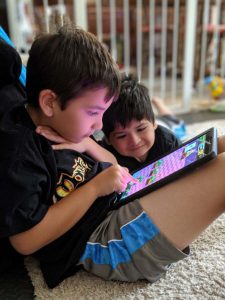 A few weeks ago I was able to watch a webinar from Lauren Enders in regards to fun activities to jumpstart AAC learning. Last week I shared how much the need for making our lessons fun and connecting with our students resonated with me, particularly as we begin to meet with our students in person and may feel pressured to make up for lost time.
A few weeks ago I was able to watch a webinar from Lauren Enders in regards to fun activities to jumpstart AAC learning. Last week I shared how much the need for making our lessons fun and connecting with our students resonated with me, particularly as we begin to meet with our students in person and may feel pressured to make up for lost time.
I loved many of the ideas Ender shared, and one that I cannot wait to use with Joey is to use wordless animated short videos. Although I have always loved wordless books it had never occurred to me to use wordless videos to encourage language use.
Language is about Connection
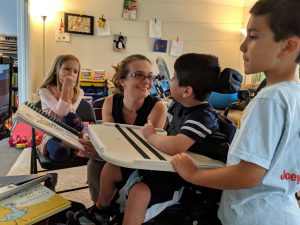 This past week I had the opportunity to listen in to AAC Learning webinar by Lauren Enders. It was chalk full of ideas, tips, and resources, and I am sure I will slowly reflect on them over time. The tips and ideas made me miss Joey and my work with him so much. I cannot wait to be back in person!
This past week I had the opportunity to listen in to AAC Learning webinar by Lauren Enders. It was chalk full of ideas, tips, and resources, and I am sure I will slowly reflect on them over time. The tips and ideas made me miss Joey and my work with him so much. I cannot wait to be back in person!
The first tip Enders gave was to ask yourself – “Would this be fun for me?”
- « Previous Page
- 1
- …
- 4
- 5
- 6
- 7
- 8
- …
- 36
- Next Page »


